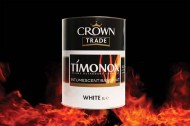 In industrial and warehousing environments, flame retardant coatings can buy valuable time to evacuate a building if fire breaks out.
In industrial and warehousing environments, flame retardant coatings can buy valuable time to evacuate a building if fire breaks out.
Here, Debbie Orr, Brand Manager at Crown Trade – manufacturers of Timonox flame retardant coatings – gives an insight into the vital role the paints play in fire protection in industrial areas.
Evacuating people from a burning building as quickly and efficiently as possible is a serious consideration and anything that can be done to slow down the spread of flames will in effect buy time for the building’s users.
Although the specification and application of flame retardant coatings is usually associated with environments such as care homes and social housing developments, their use in industrial premises is just as relevant.
Under current fire regulations, which were brought in across the UK in 2006, owners of all buildings other than single occupancy private dwellings have a duty of care to achieve and maintain conditions in buildings that reduce the risk of injury, risk to life and damage to property.
The Regulatory Reform (Fire Safety) Order (England and Wales) and the Fire (Scotland) Act require the identification of a responsible person – such as an owner, property manager or an employee – who has a duty to ensure that a fire risk assessment of the building as a whole is undertaken.
The Government has made available a series of advisory guides relating to different industry sectors, which provide details of what to look for and how to carry out such a risk assessment.
The guide, Fire Safety Risk Assessment – Factories and Warehouses, is for employers, managers, occupiers and owners of premises where the main use of the building or part of the building is a factory or warehouse including: large and small factories, manufacturing warehouses, storage warehouses and factories with warehouses.
The section ‘Décor and surface finishes of walls, ceilings and escape routes’ explains that the materials used to line walls and ceilings can contribute significantly to the spread of flame across their surface.
 Paints – even water based emulsions – contain resins or binders which may be flammable. Although a single coat of emulsion on a bare plasterboard surface is unlikely to form a hazard, over many years a build up of multiple layers of conventional paint over any surface can become a significant fire risk, particularly in corridors, stairwells and other areas forming part of a fire escape route.
Paints – even water based emulsions – contain resins or binders which may be flammable. Although a single coat of emulsion on a bare plasterboard surface is unlikely to form a hazard, over many years a build up of multiple layers of conventional paint over any surface can become a significant fire risk, particularly in corridors, stairwells and other areas forming part of a fire escape route.
In the UK, wall and ceiling lining materials are classified from Class 0 to Class 4 according to their level of resistance to flame spread & heat release, with Class 0 being the best performing material and Class 4 the worst.
A Class 0 performance is generally specified where it is necessary to restrict the use of products which ignite easily and which have a high rate of heat release and could therefore reduce the time to flashover.
It is not possible to test the performance of paint in isolation – a system able to provide a Class 0 rating on plasterboard may give a Class 3 rating when applied to wood – so our fire performance claims cover the paint and substrate in combination.
Studies have shown that the Class 0 surface of plasterboard, when painted for the first time, can be downgraded to Class 2 or worse as subsequent layers of conventional paint are applied.
This is a serious concern for companies and organisations which have a duty of care to minimise fire risk and guard against potential loss of life, injury and property damage.
A solution comes in the form of flame retardant surface coatings such as Crown Trade Timonox which are designed to improve fire performance ratings. Timonox is capable of improving a rating from Class 4 to Class 0 and while it is unlikely to prevent a fire from starting, as paint is not normally the first thing to be ignited, may provide valuable additional time for a building to be safely evacuated.
 The Crown Trade Timonox system works by limiting the oxygen around the flames through the release of non-combustible gases, and by using a formulation which provides a barrier to the flammable paint layers beneath.
The Crown Trade Timonox system works by limiting the oxygen around the flames through the release of non-combustible gases, and by using a formulation which provides a barrier to the flammable paint layers beneath.
Depending on the nature of the project, factory and warehouse owners or managers wishing to specify the application of flame retardant coatings can contact Crown Trade and we will make an assessment of the age and condition of the existing painted surfaces.
Our specialists can take a sample flake of the existing paint covering away for microscopic analysis. This will reveal which coating system needs to be applied to offer the optimum protection.
For more details contact the Crown Trade Customer Relations Team by calling 0845 389 9583, emailing info@crownpaintspec.co.uk or by visiting the website at www.crowntrade.co.uk
Crown Trade’s latest video, ‘The Right Paint For The Job,’ also includes footage of a burn test, which compares Timonox against conventional paint www.youtube.com/crowntradetv
Crown Trade Customer Relations Team
Tel: 0845 389 9583
email: info@crownpaintspec.co.uk




Comments are closed.